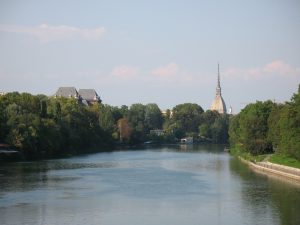Italy is a country that boasts a rich and diverse landscape, ranging from the stunning coastline of the Amalfi Coast to the rolling hills of Tuscany. However, the country’s longest river, the Po, is often overlooked by visitors in favor of more well-known attractions. Spanning over 400 miles, the Po is a fascinating and integral part of Italian history and culture.
The Po river, which flows from the Cottian Alps in the west to the Adriatic Sea in the east, has played a vital role in shaping Italy’s landscape and culture for centuries. The river is formed by several small tributaries, which come together in the Piedmont region of northern Italy. From there, the Po meanders through the Lombardy and Emilia-Romagna regions, before finally emptying into the Adriatic Sea.
The Po has been an important trade route since ancient times, with the Etruscans and Romans using it to transport goods and people throughout Italy. During the Middle Ages, the river was a key trade route for the powerful city-states of Venice, Florence, and Milan, and was also used to transport troops during times of war. In fact, the Battle of Pavia, which took place in 1525, saw the French army defeated by the forces of the Holy Roman Emperor Charles V on the banks of the Po river.
The Po has also played a vital role in agriculture and food production in Italy. The river’s fertile floodplains, known as the Po Valley, are some of the most productive agricultural areas in Italy, and are home to many of the country’s most famous food products, including Parmigiano Reggiano cheese, Prosciutto di Parma ham, and balsamic vinegar. The river’s delta region is also an important area for fishing, with many species of fish and shellfish found in its waters.
Aside from its historical and cultural significance, the Po is also home to a diverse range of flora and fauna. The river is a crucial habitat for many species of birds, including herons, ducks, and geese, and is also home to otters, beavers, and other mammals. The river’s wetlands and floodplains are also home to a wide range of plant species, including willow trees and reeds.
One of the most fascinating aspects of the Po river is its ever-changing nature. The river’s flow is heavily influenced by the seasons, with snowmelt in the spring causing the river to swell, and dry summers leading to low water levels. The river is also subject to flooding, particularly in the winter and spring months, which can cause extensive damage to the surrounding areas. In fact, the Po is often referred to as “Italy’s sorrow” due to the devastating floods that have occurred throughout history.
Despite its importance, the Po river is often overlooked by visitors to Italy. However, there are many ways to explore this fascinating waterway, from taking a leisurely boat trip along the river to exploring the quaint towns and villages that line its banks. Visitors can also take part in a range of outdoor activities, including fishing, hiking, and cycling, all of which offer a unique perspective on the river and its surroundings.
In conclusion, the Po river is a fascinating and integral part of Italian history and culture. From its role as a trade route and agricultural hub to its importance as a habitat for flora and fauna, the river has played a vital role in shaping Italy’s landscape and way of life. Whether you’re a history buff, a foodie, or a nature lover, the Po river offers something for everyone, making it a must-visit destination for anyone traveling to Italy. So why not take a trip off the beaten path and discover the wonders of this remarkable river for yourself?
For those interested in exploring the Po river, there are several options available. Boat tours are a popular choice, allowing visitors to sit back and enjoy the scenery as they glide along the river. Many of these tours also stop at towns and villages along the way, giving visitors the chance to explore the local culture and history.
For those looking for a more active experience, hiking and cycling tours are also available. These tours take visitors through the countryside surrounding the Po river, offering stunning views of the river and its surroundings. Many of these tours also include stops at local vineyards and farms, giving visitors the chance to sample some of the delicious local produce.
In addition to its natural beauty, the Po river is also home to several impressive landmarks and historical sites. One of the most notable is the city of Ferrara, which is a UNESCO World Heritage site and home to many impressive medieval buildings and works of art. Another must-see destination is the town of Piacenza, which boasts a rich history dating back to Roman times.
Perhaps the most fascinating aspect of the Po river is its role in shaping Italian culture and identity. The river has been the subject of countless works of literature and art, and has inspired countless musicians, writers, and artists throughout history. From the poetry of Dante to the paintings of Leonardo da Vinci, the Po river has played a vital role in shaping the cultural identity of Italy.

In conclusion, the Po river is a remarkable natural wonder that has played a vital role in shaping the history and culture of Italy. Whether you’re interested in history, nature, or culture, the Po river offers something for everyone. So why not take a trip off the beaten path and discover the wonders of this remarkable river for yourself?
